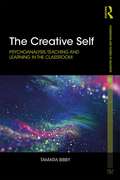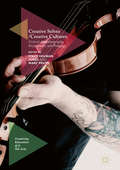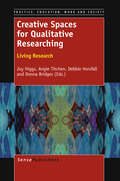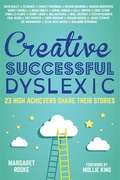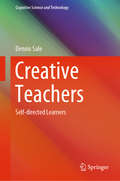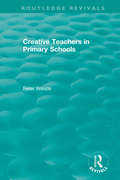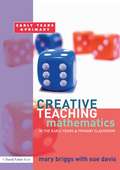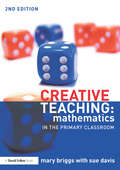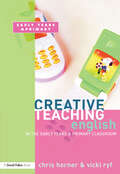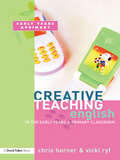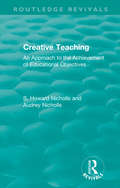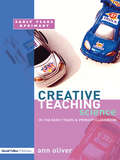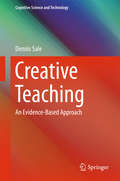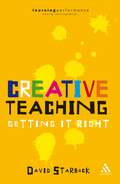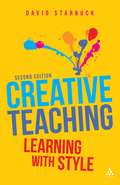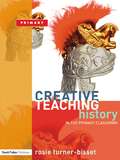- Table View
- List View
The Creative Self: Psychoanalysis, Teaching and Learning in the Classroom (Foundations and Futures of Education)
by Tamara BibbyThe Creative Self engages with the work of the psychoanalyst D.W. Winnicott to develop alternative ways of thinking about key issues at the heart of pedagogy; specifically pedagogic relationships, creativity, defiance and compliance. These issues underpin the desires and defences of professionals located in educational institutions, such as the desire to know what is best, to know how to reach all learners, normalised expectations of behaviours and outcomes, and sometimes challenging engagements with students and the curriculum. Each chapter provides both a theoretical focus and illustrative demonstrations of the ways in which Winnicott’s theories may be relocated and used productively as tools for professional and academic reflexivity. By building extensively on Winnicott’s understanding of the ways in which relationships facilitate (or hinder) the development of the self, this book extends his clinical focus on parental and analytical relationships to think about the ways in which the pedagogic relationship can provide an environment in which people may (or may fail to) develop as learners. This approach provides powerful ways of thinking about pedagogy and pedagogic relationships that stand apart from the cognitive and rationalist tradition. This focus can be used constructively to support people working in educational settings to re-establish a sense of personal and professional autonomy in an environment recently typified by compliance. The Creative Self is an engaging and innovative read appealing to postgraduate students, teachers, researchers and academics with a desire for a new analytic lens through which to explore the educational experiences of both learners and teachers in schools, colleges and universities.
Creative Selves / Creative Cultures: Critical Autoethnography, Performance, and Pedagogy
by Stacy Holman Jones Marc PruynThis book addresses and demonstrates the importance of critical approaches to autoethnography, particularly the commitment that such approaches make to theorizing the personal and to creating work that embodies a social justice ethos. Arts-based and practice-led approaches to this work allow the explanatory power of critical theory to be linked with creative, aesthetically engaging, and personal examples of the ideas at work. By making use of personal stories, critical autoethnography also allows for commenting on, critiquing, and transforming damaging and unjust cultural beliefs and practices by questioning and problematizing the relationships of power that are bound up in these selves, cultures and practices. The essays in this volume provide readers with work that demonstrates how critical autoethnography offers researchers and scholars across multiple disciplines a method for creatively putting critical theory into action. The book will be vital reading for students, researchers and scholars working in the fields of education, communication studies, sociology and cultural anthropology, and the performing arts.
Creative Selves / Creative Cultures: Critical Autoethnography, Performance, and Pedagogy
by Stacy Holman Jones Marc PruynThis book addresses and demonstrates the importance of critical approaches to autoethnography, particularly the commitment that such approaches make to theorizing the personal and to creating work that embodies a social justice ethos. Arts-based and practice-led approaches to this work allow the explanatory power of critical theory to be linked with creative, aesthetically engaging, and personal examples of the ideas at work. By making use of personal stories, critical autoethnography also allows for commenting on, critiquing, and transforming damaging and unjust cultural beliefs and practices by questioning and problematizing the relationships of power that are bound up in these selves, cultures and practices. The essays in this volume provide readers with work that demonstrates how critical autoethnography offers researchers and scholars across multiple disciplines a method for creatively putting critical theory into action. The book will be vital reading for students, researchers and scholars working in the fields of education, communication studies, sociology and cultural anthropology, and the performing arts.
Creative Spaces for Qualitative Researching: Living Research (Practice, Education, Work and Society #5)
by Joy Higgs Angie Titchen Debbie Horsfall Donna BridgesCreative Spaces for Qualitative Researching: Living Research. This book looks inward at researchers who are seeking to live their research – to embody the principles, methodologies and ethical conduct that comprises their research strategies. And, it looks outward at the living world as the focus of qualitative research. From both perspectives the editors and authors of this book have created spaces for qualitative research that provide critical and creative frameworks for conducting and living their research. A rich variety of research voices and lives are illuminated, liberated and revealed in the book. There are five sections in the book: Researching Living Practices Doing Creative Research Being a Creative Researcher Co-Creating Qualitative Research in Creative Spaces Becoming Transformed Through Creative Research.
Creative, Successful, Dyslexic: 23 High Achievers Share Their Stories
by Kelly Hoppen Mbe Zelda West-Meads Sir Richard Branson Sophie Conran Lynda La Cbe Margaret Rooke Theo Paphitis Zoe Wanamaker Cbe Sir Jackie Obe David Bailey Cbe Steven Naismith Paul Nixon Darcey Bussell Cbe Brian Conley Nigel Mccrery Ed Baines Meg Mathews Benjamin Zephaniah Mollie King Chris Robshaw Eddie Izzard Marcus Brigstocke Charley Boorman Kenny Logan Richard Rogers23 very well-known people from the arts, sport, and business worlds talk about how dyslexia affected their childhood, how they were able to overcome the challenges and use the special strengths of dyslexia to achieve great success in adulthood. Darcey Bussell CBE, Eddie Izzard, Sir Richard Branson, Meg Mathews, Zoe Wanamaker CBE, Richard Rogers, Benjamin Zephaniah, Steven Naismith, Lynda La Plante CBE, Sir Jackie Stewart OBE, Sophie Conran and others share their stories, and their advice. All reveal the enormous difficulties they faced, the strength required to overcome them, the crucial importance of adult support, and how `the different way the brain is wired' in dyslexia has enabled them to see something different in the world and to use their creativity in an exceptional way. They talk about `thinking sideways', and the ability to look at a bigger picture, the often strong visual strength, and the ability to listen, and to grasp simplicity where other people see only complexity. They also talk about how dyslexia continues to challenge them, and the ways they have found to work around this. An introduction, and final section that includes practical information about dyslexia, are written with the support of Dyslexia Action, and a percentage of profit from the book is donated to Dyslexia Action. The book will be essential reading for teachers and other professionals, and for families affected by dyslexia, and inspirational for people with dyslexia.
Creative, Successful, Dyslexic: 23 High Achievers Share Their Stories (PDF)
by Benjamin Zephaniah Brian Conley Charley Boorman Chris Robshaw Darcey Bussell Cbe David Bailey Cbe Ed Baines Eddie Izzard Kelly Hoppen Mbe Kenny Logan Lynda La Cbe Marcus Brigstocke Margaret Rooke Meg Mathews Mollie King Nigel Mccrery Paul Nixon Richard Rogers Sir Jackie Obe Sir Richard Branson Sophie Conran Steven Naismith Theo Paphitis Zelda West-Meads Zoe Wanamaker Cbe23 very well-known people from the arts, sport, and business worlds talk about how dyslexia affected their childhood, how they were able to overcome the challenges and use the special strengths of dyslexia to achieve great success in adulthood. Darcey Bussell CBE, Eddie Izzard, Sir Richard Branson, Meg Mathews, Zoe Wanamaker CBE, Richard Rogers, Benjamin Zephaniah, Steven Naismith, Lynda La Plante CBE, Sir Jackie Stewart OBE, Sophie Conran and others share their stories, and their advice. All reveal the enormous difficulties they faced, the strength required to overcome them, the crucial importance of adult support, and how `the different way the brain is wired' in dyslexia has enabled them to see something different in the world and to use their creativity in an exceptional way. They talk about `thinking sideways', and the ability to look at a bigger picture, the often strong visual strength, and the ability to listen, and to grasp simplicity where other people see only complexity. They also talk about how dyslexia continues to challenge them, and the ways they have found to work around this. An introduction, and final section that includes practical information about dyslexia, are written with the support of Dyslexia Action, and a percentage of profit from the book is donated to Dyslexia Action. The book will be essential reading for teachers and other professionals, and for families affected by dyslexia, and inspirational for people with dyslexia.
Creative Teachers: Self-directed Learners (Cognitive Science and Technology)
by Dennis SaleThis book offers teaching/training professionals an evidence-based pedagogic guide to teaching effectively, efficiently and creatively – also known as Creative Teaching Competence. Firstly it summarizes the extensive research on human psychological functioning relating to learning and how this can be fully utilized in the design and facilitation of quality learning experiences that maximize attainment and engagement opportunities. Secondly, it demonstrates what creativity actually ‘looks like’ in terms of specific teaching practices, modeling the underpinning processes (syntax) of creative learning design. It then establishes Metacognitive Capability as the superordinate twenty-first century competency; in that this unique human attribute can significantly enhance the cognitive and motivational strategies essential for facilitating self-directed learning and wellbeing. The book helps teaching/training professionals to thoughtfully apply evidence-based knowledge and strategies to today’s challenges, such as developing self-directed learners, enhancing intrinsic motivation, utilizing technology for learning and teaching, developing curricula for twenty-first century competencies and optimally framing and developing the heightened teacher expertise required today.
Creative Teachers in Primary Schools (Routledge Revivals)
by Peter WoodsIs creative teaching still possible in English schools? Can teachers maintain and promote their own interests and beliefs as well as deliver a prescribed National Curriculum? Originally published in 1995, this book explores creative teachers’ attempts to pursue their brand of teaching despite the changes. Peter Woods has discovered a range of strategies and adaptations to this end among such teachers, including resisting change which runs counter to their own values; appropriating the National Curriculum within their own ethos; enhancing their role through the use of others; and enriching their work through the National Curriculum to provide quality learning experiences. If all else fails, such teachers remove themselves from the system and take their creativity elsewhere. A strong theme of self-determination runs through these experiences. While acknowledging hard realities, the book is ultimately optimistic, and a tribute to the dedication and inspiration of primary teachers. The book makes an important contribution to educational theory, showing a range of responses to intensification as well as providing many detailed examples of collaborative research methods.
Creative Teachers in Primary Schools (Routledge Revivals)
by Peter WoodsIs creative teaching still possible in English schools? Can teachers maintain and promote their own interests and beliefs as well as deliver a prescribed National Curriculum? Originally published in 1995, this book explores creative teachers’ attempts to pursue their brand of teaching despite the changes. Peter Woods has discovered a range of strategies and adaptations to this end among such teachers, including resisting change which runs counter to their own values; appropriating the National Curriculum within their own ethos; enhancing their role through the use of others; and enriching their work through the National Curriculum to provide quality learning experiences. If all else fails, such teachers remove themselves from the system and take their creativity elsewhere. A strong theme of self-determination runs through these experiences. While acknowledging hard realities, the book is ultimately optimistic, and a tribute to the dedication and inspiration of primary teachers. The book makes an important contribution to educational theory, showing a range of responses to intensification as well as providing many detailed examples of collaborative research methods.
Creative Teaching: Mathematics in the Early Years and Primary Classroom
by Mary BriggsCreative Teaching is not only for the arts: this unique and stimulating book shows how mathematics and mathematics teaching can be creative, exciting and enjoyable. Offering teachers a dynamic and different perspective on mathematics, it enables them to see and teach in creative ways that will develop their pupil’s mathematical thinking potential. The book: supports the government’s Primary Strategy "Excellence and Enjoyment" covers both primary and early years range includes issues for reflection, discussion points and case studies addresses new teacher training modules on creativity and maths Aimed at primary and early years trainee teachers, NQTs and experienced teachers, this is a timely publication for teachers and schools seeking to broaden their maths curriculum, making it more creative and appealing to young minds.
Creative Teaching: Mathematics in the Early Years and Primary Classroom
by Mary BriggsCreative Teaching is not only for the arts: this unique and stimulating book shows how mathematics and mathematics teaching can be creative, exciting and enjoyable. Offering teachers a dynamic and different perspective on mathematics, it enables them to see and teach in creative ways that will develop their pupil’s mathematical thinking potential. The book: supports the government’s Primary Strategy "Excellence and Enjoyment" covers both primary and early years range includes issues for reflection, discussion points and case studies addresses new teacher training modules on creativity and maths Aimed at primary and early years trainee teachers, NQTs and experienced teachers, this is a timely publication for teachers and schools seeking to broaden their maths curriculum, making it more creative and appealing to young minds.
Creative Teaching: Mathematics in the Primary Classroom
by Mary Briggs Sue DavisThis stimulating text shows how primary mathematics can be creative, exciting and enjoyable. Offering teachers a dynamic and different perspective, it enables them to see and teach in creative ways that will develop their pupil’s mathematical thinking potential. Creative Teaching: Mathematics in the Primary Classroom encourages students, trainees and practicing teachers to envision and develop a classroom where children can take risks, enjoy and experiment with mathematical thinking, and discover and pursue their interests and talents in an imaginative yet purposeful way. This second edition contains key updates to reflect the changes to the primary curriculum and includes: new sections on: specialist teaching, parental engagement and approaches to homework; creative classroom environments; working walls, displays and outdoor settings; links to assessment, speaking, listening and learning theory; use of media, film, news and stories for creative learning; cross-curricula work. Featuring reflective tasks in every chapter, this book will prove essential and inspiring reading for all trainee and practising teachers looking to develop their creative practice. Aimed at primary and early years trainee teachers, NQTs and experienced teachers, this is a timely publication for teachers and schools seeking to broaden their maths curriculum, making it more creative and appealing to young minds.
Creative Teaching: Mathematics in the Primary Classroom
by Mary Briggs Sue DavisThis stimulating text shows how primary mathematics can be creative, exciting and enjoyable. Offering teachers a dynamic and different perspective, it enables them to see and teach in creative ways that will develop their pupil’s mathematical thinking potential. Creative Teaching: Mathematics in the Primary Classroom encourages students, trainees and practicing teachers to envision and develop a classroom where children can take risks, enjoy and experiment with mathematical thinking, and discover and pursue their interests and talents in an imaginative yet purposeful way. This second edition contains key updates to reflect the changes to the primary curriculum and includes: new sections on: specialist teaching, parental engagement and approaches to homework; creative classroom environments; working walls, displays and outdoor settings; links to assessment, speaking, listening and learning theory; use of media, film, news and stories for creative learning; cross-curricula work. Featuring reflective tasks in every chapter, this book will prove essential and inspiring reading for all trainee and practising teachers looking to develop their creative practice. Aimed at primary and early years trainee teachers, NQTs and experienced teachers, this is a timely publication for teachers and schools seeking to broaden their maths curriculum, making it more creative and appealing to young minds.
Creative Teaching: English in the Early Years and Primary Classroom
by Chris Horner Victoria RyfPresenting a range of exciting activities that support the development of creative English lessons within the existing structures of the Foundation Curriculum and the National Curriculum, this book: is packed full of interactive and creative teaching strategies provides guidance on assessing creative work highlights opportunities for creative literacy activities across the curriculum covers ages 3-11.
Creative Teaching: English in the Early Years and Primary Classroom
by Chris Horner Victoria RyfPresenting a range of exciting activities that support the development of creative English lessons within the existing structures of the Foundation Curriculum and the National Curriculum, this book: is packed full of interactive and creative teaching strategies provides guidance on assessing creative work highlights opportunities for creative literacy activities across the curriculum covers ages 3-11.
Creative Teaching: An Approach to the Achievement of Educational Objectives (Routledge Revivals)
by S. Howard Nicholls Audrey NichollsIn their highly successful practical guide, Developing a Curriculum, Howard and Audrey Nicholls provided a basic guide to curriculum planning for both practising and prospective teachers. In this second volume, originally published in 1975, some of the ideas outlined there at an elementary level are developed, with the aim of encouraging and guiding the development of ‘custom built’ curricula. Grasping the fundamental ideas and concepts of curriculum development is one problem for teachers, translating them into practice is another, and this book will go a long way to solving both problems. The development of justifiable and purposeful curricula for the particular pupils he is teaching is a primary task for any teacher, as is the modification of these curricula as circumstances and ideas change and the teacher forms his assessment of pupils’ needs and progress. The theoretical background to be taken into account when arriving at general curricular decisions is considered throughout, and groups, aids, organisation, records and assessment are all treated as essential items for the curriculum planner. Nor is the final problem, which the theorists often neglect, forgotten, namely that of implementing modifications or innovations once the curriculum has been created.
Creative Teaching: An Approach to the Achievement of Educational Objectives (Routledge Revivals)
by S. Howard Nicholls Audrey NichollsIn their highly successful practical guide, Developing a Curriculum, Howard and Audrey Nicholls provided a basic guide to curriculum planning for both practising and prospective teachers. In this second volume, originally published in 1975, some of the ideas outlined there at an elementary level are developed, with the aim of encouraging and guiding the development of ‘custom built’ curricula. Grasping the fundamental ideas and concepts of curriculum development is one problem for teachers, translating them into practice is another, and this book will go a long way to solving both problems. The development of justifiable and purposeful curricula for the particular pupils he is teaching is a primary task for any teacher, as is the modification of these curricula as circumstances and ideas change and the teacher forms his assessment of pupils’ needs and progress. The theoretical background to be taken into account when arriving at general curricular decisions is considered throughout, and groups, aids, organisation, records and assessment are all treated as essential items for the curriculum planner. Nor is the final problem, which the theorists often neglect, forgotten, namely that of implementing modifications or innovations once the curriculum has been created.
Creative Teaching: Science in the Early Years and Primary Classroom
by Ann OliverPractical, useful and informative, this book provides ideas and suggestions on how to interpret and develop the primary science curriculum in an interesting and challenging way. Bringing together creative thinking and principles that still meet National Curriculum requirements, the themes in the book encourage teachers to: teach science with creative curiosity value the unpredictable and unplanned thrive on a multiplicity of creative approaches, viewpoints and conditions be creative with cross-curricular and ICT opportunities reflect on their own practice. For teachers new and old, this book will make teaching and learning science fun by putting creativity and enjoyment firmly back onto the primary agenda.
Creative Teaching: Science in the Early Years and Primary Classroom
by Ann OliverPractical, useful and informative, this book provides ideas and suggestions on how to interpret and develop the primary science curriculum in an interesting and challenging way. Bringing together creative thinking and principles that still meet National Curriculum requirements, the themes in the book encourage teachers to: teach science with creative curiosity value the unpredictable and unplanned thrive on a multiplicity of creative approaches, viewpoints and conditions be creative with cross-curricular and ICT opportunities reflect on their own practice. For teachers new and old, this book will make teaching and learning science fun by putting creativity and enjoyment firmly back onto the primary agenda.
Creative Teaching: An Evidence-Based Approach (Cognitive Science and Technology)
by Dennis SaleThis book contains an evidence-based pedagogic guide to enable any motivated teaching/training professional to be able to teach effectively and creatively. It firstly summarises the extensive research field on human psychological functioning relating to learning and how this can be fully utilised in the design and facilitation of quality learning experiences. It then demonstrates what creativity actually 'looks like' in terms of teaching practices, modelling the underpinning processes of creative learning design and how to apply these in lesson planning. The book, having established an evidence-based and pedagogically driven approach to creative learning design, extensively focuses on key challenges facing teaching professionals today. These include utilising information technologies in blended learning formats, differentiating instruction, and developing self-directed learners who can think well. The main purpose of the book is to demystify what it means to teach creatively, explicitly demonstrating the principles of good pedagogic design and communication strategies that underpin such activity. The message is clear - creative teaching competence is both a highly useful and a learnable capability.
Creative Teaching: Getting it Right (Practical Teaching Guides)
by David StarbuckMost teachers accept that learning is most effective when it is enjoyable, but they are given little direct advice about how to achieve the creative and motivating classrooms that educationalists appeal for. This fascinating book creates a coherent picture of how teachers can make learning easier and more enjoyable for their pupils, including activity ideas, self-evaluation exercises and adaptable action plans for improving both classroom and whole-school ethos.
Creative Teaching: Learning with Style
by David StarbuckFindout how you can be more creative and encourage more creativity from yourstudents without having to put in hours of extra preparation. This concise,practical guide will help you to gain the confidence to move out of yourcomfort zone and take some risks, in order to meet the needs of students with avariety of learning styles and needs. Thisupdated edition of Creative Teaching includes practical activities and avariety of strategies to help you to plan exciting, pupil-centred lessons thatare easy to integrate into your schemes of work. There is newmaterial on: • independent learning - offering a clear framework for design, delivery andassessment of lessons• transforming the ethos of the school to a positive, creative one• the companion website - offering printable or downloadable checklists,questionnaires and templates. Alongwith adaptable action plans for improving both your classroom and whole-schoolethos, this book creates a cohesive picture of how teachers can make learningeasier and more enjoyable for themselves and their pupils.
Creative Teaching: Getting it Right (Practical Teaching Guides)
by David StarbuckMost teachers accept that learning is most effective when it is enjoyable, but they are given little direct advice about how to achieve the creative and motivating classrooms that educationalists appeal for. This fascinating book creates a coherent picture of how teachers can make learning easier and more enjoyable for their pupils, including activity ideas, self-evaluation exercises and adaptable action plans for improving both classroom and whole-school ethos.
Creative Teaching: Learning with Style
by David StarbuckFindout how you can be more creative and encourage more creativity from yourstudents without having to put in hours of extra preparation. This concise,practical guide will help you to gain the confidence to move out of yourcomfort zone and take some risks, in order to meet the needs of students with avariety of learning styles and needs. Thisupdated edition of Creative Teaching includes practical activities and avariety of strategies to help you to plan exciting, pupil-centred lessons thatare easy to integrate into your schemes of work. There is newmaterial on: • independent learning - offering a clear framework for design, delivery andassessment of lessons• transforming the ethos of the school to a positive, creative one• the companion website - offering printable or downloadable checklists,questionnaires and templates. Alongwith adaptable action plans for improving both your classroom and whole-schoolethos, this book creates a cohesive picture of how teachers can make learningeasier and more enjoyable for themselves and their pupils.
Creative Teaching: History in the Primary Classroom
by Rosie Turner-BissetDesigned specifically for teachers with little subject knowledge or experience in history, this book provides trainees with the confidence they need to teach primary history. Based on Curriculum 2000, the book provides valuable step-by-step guidance on how to create, plan, develop, organize and assess high-quality teaching activities in primary history. This book: is full of teaching approaches, practical ideas, teaching activities, real-life case studies and vignettes of good teaching practice; covers both conventional and modern approaches - such as drama, role-play, story telling, music and dance; and explains how each approach can be adapted to suit all primary ages and abilities. Children with a range of learning needs and styles respond with enthusiasm to a wide variety of teaching approaches - and this book provides trainee teachers with that repertoire and variety.
